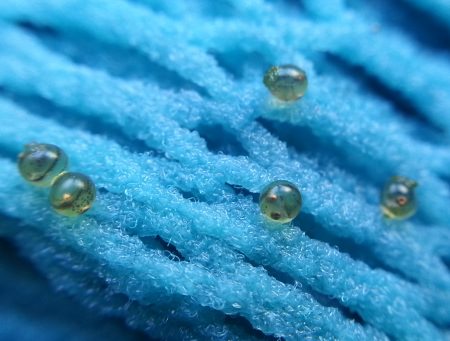| Back to Back Issues Page |
 |
|
The Goldfish Gazette, Issue #118 Goldfish Egg Incubation October 31, 2023 |
Goldfish Care TipsA Free Monthly Resource For Goldfish Enthusiasts In This Issue Proper care of eggs after your Goldfish have spawned is the first step to raising fry successfully. Goldfish Egg Incubation
Eggs close to hatchingBreeding Goldfish can be an exciting venture, but it requires careful attention to detail, particularly during the Goldfish egg incubation period. This guide will provide you with instructions on how to maximize egg hatching numbers and give your Goldfish fry the best possible start.Optimal Water ConditionsThe first step in successful Goldfish egg incubation is to ensure optimal water conditions.Goldfish eggs require a specific temperature range if they are to hatch within 3-5 days, the ideal time frame. The ideal water temperature for Goldfish eggs is between 68 and 75 degrees Fahrenheit (20 to 24 degrees Celsius). Temperatures below this range slow hatching, above speed it up, both not good for fry health. There is some evidence that twin tailed varieties produce fewer single tails if the eggs are kept at the higher end of the temperature range. The water in your hatching tank should be fresh, clean and free from harmful chemicals, ready to accept the spawning mops or whatever was used to collect the eggs on. It should also have a good level of GH (general hardness) as Goldfish prefer hard water and it has been found that excessively soft water can affect fry development in the egg. PH should also be 7+ for the same reason. Water changes shouldn't be necessary before the eggs hatch unless there is a large number of eggs laid, with a correspondingly large quantity of dead eggs. The dead eggs could cause an ammonia spike. If you have a low fertility rate, monitor the water parameters morning and night. If you are using the spawning container to hatch the eggs in, you will need to do a large water change to remove milt and other spawning detritus. Fungus ControlFungus control is a vital part of Goldfish egg incubation. Goldfish eggs are susceptible to fungal attack spread from dead eggs. To prevent fungal growth, you can add an anti-fungal medication to the water such as Methylene Blue. The water can be quite blue without harming the eggs. However, the down side of using such controls is you can’t run a cycled filter, as the beneficial bacteria will be killed.AerationAeration is another important aspect of raising Goldfish fry. Goldfish eggs need a good supply of oxygen to develop properly. An air stone helps ensure good water flow past the eggs and breaks up surface scum.Hatching ProcessThe hatching process usually begins within 72 to 96 hours after the eggs are laid. During this time, it's important to monitor the water conditions closely and make any necessary water changes.Once the eggs hatch, the Goldfish fry will not immediately swim around. They will attach themselves to the sides of the tank and feed off their yolk sacs. During this period, it's important not to feed them as feeding only pollutes the water. After a few days the fry will start swimming around and will need to be fed. The easiest option is to feed newly hatched brine shrimp as soon as the fry are free swimming. A good indication of fry receiving sufficient food is them all growing at the same rate, with no obvious large fry present in the brood. In conclusion, Goldfish egg incubation requires careful attention to water temperature, water quality, fungus control, aeration, and surface scum control. By following these steps, you can increase your chances of successfully raising Goldfish fry. It's a fascinating process that can be rewarding for both beginners and experienced goldfish keepers alike. That’s why we keep doing it.
Comments? Ideas? Feedback? I'd love to hear from you. Just reply to this e-zine and tell me what you think, or what topics you want to be covered. Next Month's Topic Books about Goldfishwww.facebook.com/aboutgoldfish |
| Back to Back Issues Page |
